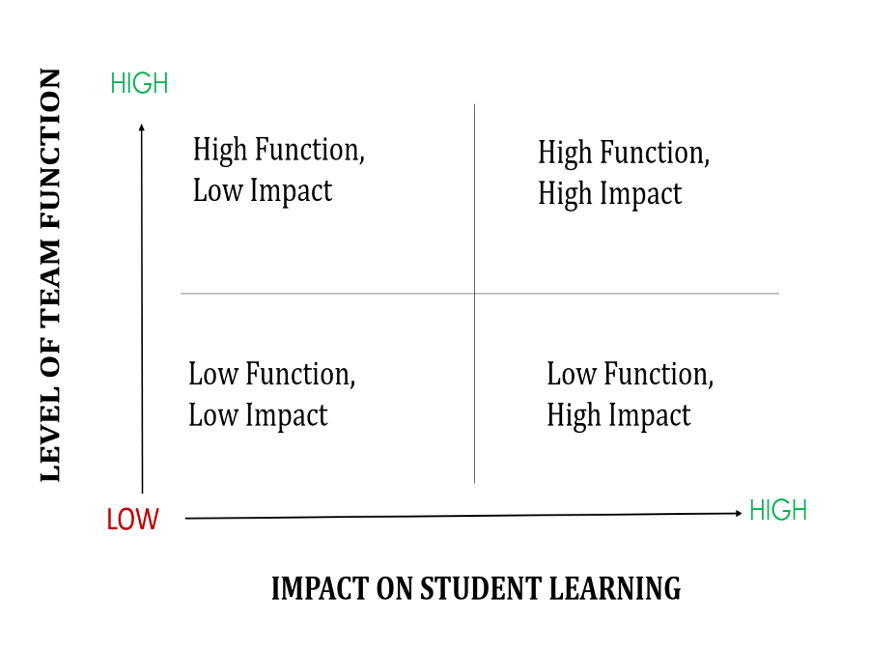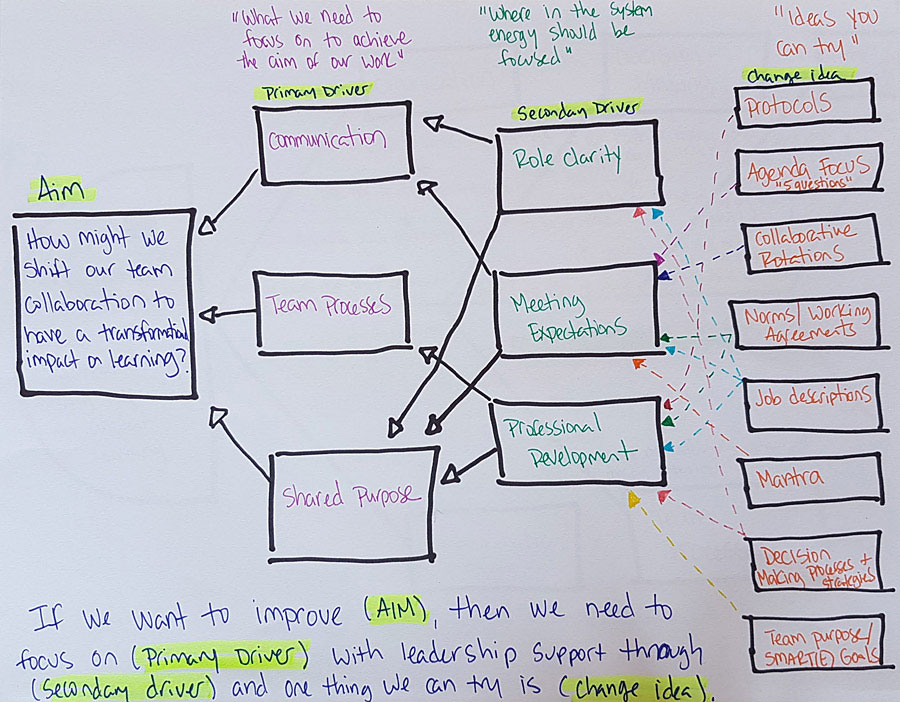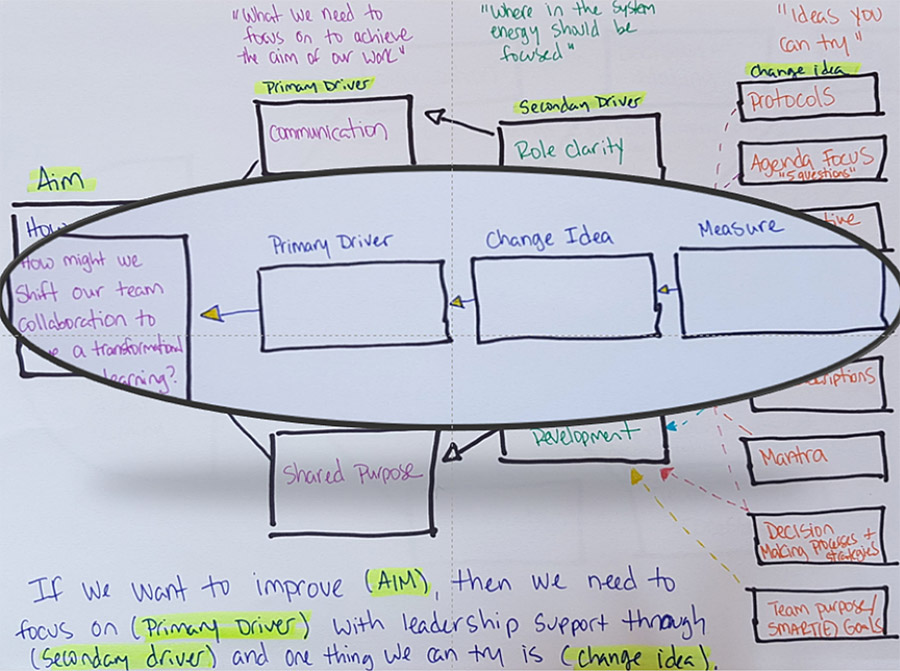
Schools use teaming as a key structure to maximize learning. Teaming is important because the product of our collective work tends to be better than what we individually produce. Additionally, the diverse perspective of team members yields more thoughtful decisions. The challenge for leaders is, how might we lead our teams on a path to transform learning?
Leading a high functioning team that transforms learning is easier said than done. Principals and teacher leaders face many challenges keeping the focus on learning. Teams often get bogged down with operational tasks in meetings, running out of time to discuss learning. Some teams struggle with inequity of voice and lack of engagement amongst team members.
The function-impact matrix is a helpful framework for examining learning impact. Teams fall into one of the four quadrants below, according to Elisa McDonald, author of The Skillful Team Leader. McDonald says high functioning teams have a shared purpose for collaboration, agreements in place to promote collaboration and accountability, collectively agree upon and use tools for meeting efficiency, work towards a shared goal, engage in an inquiry process and have agreed upon decision-making processes.

Source: Function-Impact; Theory of Action/Driver Diagram (The Skillful Team Leader)
Teams that positively impact learning ground their shared purpose in learning, team agreements are action-oriented towards learning, tools used in meetings result in improved learning outcomes, goals are written using learning data, teams use data for decision making as part of an inquiry cycle and decision-making processes are centered around learning data that lead to improved teaching practices.
Taking time to understand your team’s functioning and impact is a transformational leadership practice. I recently facilitated this process with a group of teacher leaders, having them reflect on where their teams fell on the matrix. Using that data, the team crafted a general problem statement, “Our team struggles to collaborate in a way that impacts learning.”
With the overarching problem statement in mind, teacher leaders brainstormed contributing factors to the problem. They created a picture of the problem, a fishbone diagram, which allowed them to get perspective by looking at the problem. Using a chain of “why’s” while exploring the contributing factors pushed the teacher leaders to operationalize their thinking.
Here’s an example of how they used a chain of why’s to dial down to a root cause for one of the factor’s contributing to their problem.
Organization
While creating the fishbone diagram, the teacher leaders unpacked four other categories contributing to their problem.
| Category | Root Cause |
| Communication | We are not clear on who should be setting the agenda.
|
| Team Processes | We are confused about who should be present in meetings and how to ensure equity of voices.
|
| Decision-Making | We are not clear on who has the authority to make decisions.
|
| Time Management | We are not clear which topics take priority in our meetings, so we don’t always use our time well. |
Taking time to unpack the problem in a deep and thoughtful way helps teams create a path forward, a theory of action, which begins with articulating a goal for improvement. Inspired by Warren Berger’s book, A More Beautiful Question, I like writing goals in the form of a question. When teams write goals in the form of a question, they tackle their problem of practice using an inquiry mindset. If we reframe the teacher leaders’ problem statement from above in the form of a question, they have a goal for their work together: How might we shift our team collaboration to have a transformational impact on learning?
With a goal in place, it is time to identify what will drive the theory of action- the things teams should focus their energy on to get closer to their goal (primary drivers) and the things that need to be in place within the larger system to support teams to get closer to their goal (secondary drivers).
Using our teacher leader example from above, three primary drivers were identified. These drivers came from the categories on the fishbone diagram and are supported by the literature on effective teams: communication, team processes, and establishing a shared purpose (a combination of the root causes derived from organization, decision-making, and time management on the fishbone diagram).
While these primary drivers focus the teams’ improvement efforts, in some cases, there may be secondary drivers that need some of our energy and focus. In our example, teacher leaders will need support from school leadership on these secondary drivers: role clarity, establishing meeting expectations to help prioritize work, and creating opportunities for professional learning, where needed.
The final steps in creating a path forward are identifying change ideas that teacher leaders can try with their team and identifying what measures will be collected so they know whether or not the change is an improvement.

Theory of Action/Driver Diagram
It is helpful to use this sentence frame when navigating your improvement journey through the theory of action (also called a driver diagram): “If we want to improve (insert aim) then we need to focus on (primary driver) and we should focus energy within the system on (secondary driver). One thing we can try is (change idea). We will collect (measure) as evidence, so we know whether our change is an improvement.

A Path Forward
The teacher leaders I worked with chose different pathways forward to reach their shared goal based on the needs of their team. One teacher wanted to revisit their norms after realizing that none of the team’s six norms were related to improving learning. Another teacher leader wanted to make changes to the agenda format to ensure the focus was on learning, not logistics. A third teacher leader wanted to use protocols during meetings to ensure equity of voice amongst team members.
As you try different change ideas and learn which ideas lead to improved outcomes, your theory of action will evolve, ultimately transforming student learning and your team’s function and impact.
Kristen MacConnell is the Director of the Teacher Training Center Programs. Kristen teaches courses on teacher leadership through the Principals Training Center and has published articles and a book chapter on teacher leadership. Kristen has worked in Chile as a ES Counselor, K-5 Literacy Specialist, Assistant Director of the Early Years School and Director of Curriculum and Professional Development. Kristen will be joining the American School of Barcelona for the 2022-2023 school year as the ES Principal.
Twitter: @kristenmacc